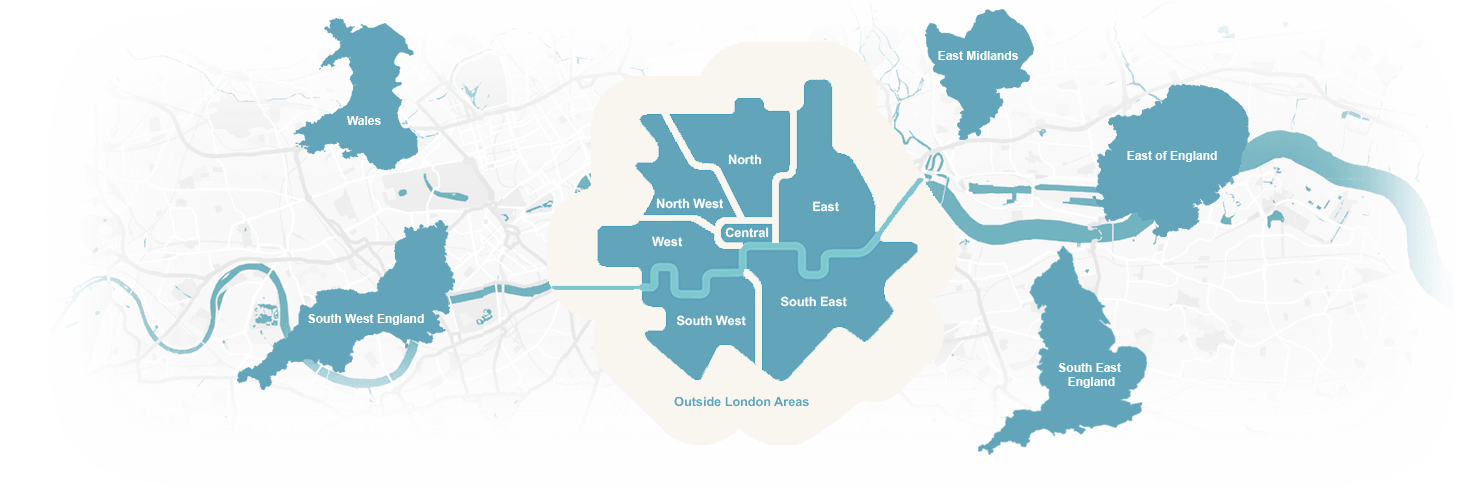When you are getting ready to move from one home to another, or to move from one office space to another, it is important that you don’t just jump right in. You could find yourself overwhelmed, over budget and overextended. The first thing you should do when you know a removal East London is on your horizon is to take a look around at your belongings. Look at everything, including the furniture, and determine whether or not you really want or need it in your new place. By freeing yourself, whether through donation, binning or selling, of a number of items, you will be able to start fresh in the new place and decorate the way you want. Plus, you could save money on the moving vehicle, the storage unit and the number of boxes and packing supplies you will need to purchase.
Having a look around for yourself is always a good idea. But you could also have us take a look around as well. This is called a home assessment and our professional movers can complete one quickly and easily. This assessment will give you a good idea of how many boxes to purchase, what size storage space you will need and even how many crew members and what size moving vehicle will be the best options for you. It is a worthwhile investment to make your removal come off without a hitch.

East London could be many things. It could be the eastern half of Greater London; it could be the former sub region, as determined by the London Plan; or it could be a part of the capital city that generally lies east of the city centre. The London Plan is a planning document that was first written by the city’s mayor in 2004. When it was first completed, the document contained five sub regions: North, South, East, West and Central. In 2008, however, the document was revisited and the sub regions were changed. The whole idea of the plan is to act as a strategy for spatial development and one of the objectives is to make the city a better place to live. So in 2008, the sub regions were changed to reflect these objectives and now include five sub regions, listed as West, North, North East, South West and South East.
But that doesn’t mean that East London no longer exists. It formerly included a population of nearly 2 million people, who now live in either North East London or South East London, according to the new plan. The former designation included the boroughs of Bexley, Barking and Dagenham, Greenwich, the City of London, Lewisham, Havering, Newham, Hackney, Tower Hamlets and Redbridge. Today, the combined sub regions of South East and North East London comprise the boroughs of Barking & Dagenham, Havering, the City of London, Newham, Redbridge, Tower Hamlets, Waltham Forest, Bexley, Bromley, Lewisham, Greenwich and Southwark. These two sub regions today are home to 2.7 million people and 1.4 million jobs.
The former East sub region was also home to the London portion of the Thames Gateway zone. This is an important part of London’s plan for redevelopment and regeneration of many of the city’s least-developed areas. The Thames Gateway zone stretches from inner east London seventy kilometres on either side of the Thames Estuary and the River Thames. Much of the area consists of brownfields and is considered development opportunities for the city. It extends beyond Greater London into non-metropolitan districts and all the way to the coast.
While Central London is home to the nation’s most important buildings, like the seats of Government, the Law Courts and Parliament, as well as many cultural attractions, East London also has its fair share of great places to visit. Take your guests or the kids to see Christ Church Spitalfields or the Rio Cinema. The Bethnal Green Museum of Childhood is sure to entertain, as will Sutton House. Another theatre in East London is Hackney Empire, built back in 1901 and hosting the great Charlie Chaplin a number of times. For more contemporary entertainment, head to the Electric Blue Gallery, the Mpeke Fine Art Studio, or the White Cube. You could also see what the Geffrye Museum has on display about English interior design and visit the Whitechapel Art Gallery, which has been an East End institution since 1901.


While the London Plan may have changed its definition of East London, dropping it from the map, this part of the capital city has plenty to offer its residents and visitors. And the fact that it is an area full of development opportunities means that there are plenty of affordable places to live in East London as well. Specifically in South East London, one can find a number of areas that are considered “budget”, such as Dulwich, Crystal Palace and Brixton. Clapton, Hackney, Bethnal Green and Leytonstone, as well as Walthamstow and Wouth Woodford are also very affordable parts of the city. The postcode areas, beginning with E, in East London, have few very expensive areas other than Whitechapel and Isle of Dogs. Docklands is another pricey area, but there are plenty of places to find affordable housing as well.
Ease your way into your East London move by giving yourself enough time to research your removal needs. Throwing things into boxes and piling them into the back of the car is a guaranteed recipe for disaster, whether in the form of broken items or stress. Call in the team from Removal Company and you are sure to find yourself much more relaxes than otherwise, especially when you consider all the combined years of experience that our crew members have. While you can’t always buy peace of mind, you can come pretty close when you hire Removal Company for your East London move. And you’ll be pleased to find that it won’t cost you an arm and a leg!.
Areas we cover
- Premier Relocation Company Canary Wharf

- Trouble-free Relocation Services Ilford

- Dependable Movers Bow

- Recommended Man with Van Removal Services E7

- Fast Household Removals E10

- Low Cost Removals Services E6

- Outstanding Man and a Van Hire IG11

- Top-class Man and Van Removal Service E9

- Leading Removal Company E18

- Top-notch Man and Van Service E1W

- Reliable Relocation Company E5

- High-quality Removal Services E16

- Amazing Household Removals E15

- Cheap Removals Prices E3

- Incomperable Corporate Removals E8

- Dedicated Movers E11

- Trustworthy Man with Van Removal Services E17

- Incomperable Office Removals E1

- Professional Man and a Van Hire E2

- Highly Rated Removal Company E14

- Efficient Man with Van Removal Service IG8

- Best Man with a Van Removals IG6

- Cheap House Removals Prices E12

- Inexpensive Moving Service E13

- Reliable Removal Company IG1

- High-quality Removal Service IG3

- Efficient Moving Service IG7

- Great Removal Services RM6

- Amazing Relocation Service RM14

- Inexpensive Removals Prices RM9

- Expert Movers RM10

- Best Value Man with Van Removal Service RM13

- Incomperable Furniture Removal IG2

- Top Rated Removals Services IG9

- Excellent Man with Van Removal Service IG5

- Best House Removals RM19

- Top-class Moving Company RM1

- High-quality Moving Service RM11

- Low Cost Removals and Storage RM8

- Helpful Removal Experts RM7

- Exceptional Man with a Van Removals Barkingside

- Trustworthy Moviers Ardleigh Green

- Skilled Moving Experts Barking

- Great Relocation Services Beckton

- Incomperable Removals Service Becontree Heath

- Fast Corporate Removals Cambridge Heath

- Top-level Man with Van Removal Service Canning Town

- Premier Moving Company Chadwell Heath

- Expert Man and a Van Hire Chingford

- Professional Relocation Service Chase Cross

- Inexpensive Man with Van Removal Services Collier Row

- Best Office Removals Bethnal Green

- Dependable Removal Man Blackwall

- High-quality Removal Service Harold Park

- 5-Star Home Removals Harold Wood

- Outstanding Removals and Storage Harold Hill

- Best Removal Company Havering-atte-Bower

- Exquisite Man with Van Removal Services Highams Park

- Great Relocation Services Homerton

- Fast Removals Services Hornchurch

- Reliable Man and a Van Hire Isle of Dogs

- Professional Relocation Company Noak Hill

- Leading Removals and Storage Company North Ockendon

- Cheap Moving Cosrts North Woolwich

- Efficient Relocation Services Old Ford

- Recommended Removal Service Plaistow

- Amazing Movers in Poplar

- Affordable Removals Prices Cubitt Town

- Excellent Office Removals Lea Bridge

- Best Value Moving Services Leamouth

- Trustworthy Moving Experts Leyton

- Recommended Man and Van Leytonstone

- Dedicated Men and Van Limehouse

- Top-class Relocation Service Little Ilford

- Premier Removal Service Lower Clapton

- Trouble-free Removal Service Marks Gate

- Incomperable Relocation Services Mile End

- Highly Rated Relocation Company Millwall

- Top-notch House Removals Cranham

- Cheap Removals Service Creekmouth

- Exceptional Movers Service Dagenham

- Great Moving Company Dalston

- Incomperable House Removals East Ham

- Recommended Removals and Storage Service Elm Park

- Cheap Relocation Prices Emerson Park

- Fast Man and Van Service Redbridge

- High-quality Furniture Removal Service Romford

- 5-Star Removal Man Services Rush Green

- Helpful Mover Services Shadwell

- Cheap Moving Costs Silvertown

- Trouble-free Man and Van Service South Hackney

- Reliable House Removals Services Forest Gate

- Great Relocation Company Gants Hill

- Top-notch Man and Van Removal Services Gidea Park

- Inexpensive Office Removal Service Hackney Marshes

- Dedicated Movers in Hackney Wick

- Exceptional Moving Service Haggerston

- Professional Man and Van Removals Upminster

- Leading Corporate Removal Company Upper Clapton

- Dependable Removal Firm Upton Park

- Best Relocation Services Walthamstow

- Reliable Moving Services Wanstead

- Highly Rated Relocation Firm Wapping

- Fast Moving Service South Hornchurch

- Fully Vetted Movers South Woodford

- Amazing Man and Van Hire Spitalfields

- Exquisite Relocation Service Stepney

- Low Cost Removal Services Stratford

- Exceptional Moving Company Wennington

- First-class Man with Van Removal Service West Ham

- Outstanding House Removals Whitechapel

- Professional Man with a Van Removals Woodford

My office just moved into a new building. We hired Amazing Moves for the job and we were all pleased with the results.
My husband and I were really impressed with the removal services we got from Amazing Moves.
I would use this removals company again and will recommend to my friends and family.
This team moved our belongings very quickly, carefully and safely to the new address. They also disassembled/reassembled all furniture for us for no additional charge.
 Amazing Moves
020 3970 0488
Unit 3 Hanworth Trading Estate Hampton Road West
Amazing Moves
020 3970 0488
Unit 3 Hanworth Trading Estate Hampton Road West
Show all

 Get a Quote
Get a Quote

